

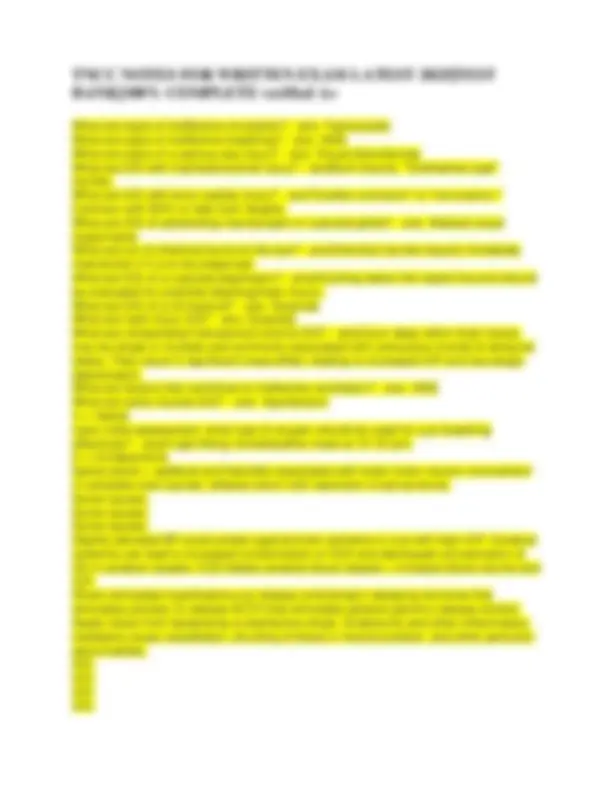
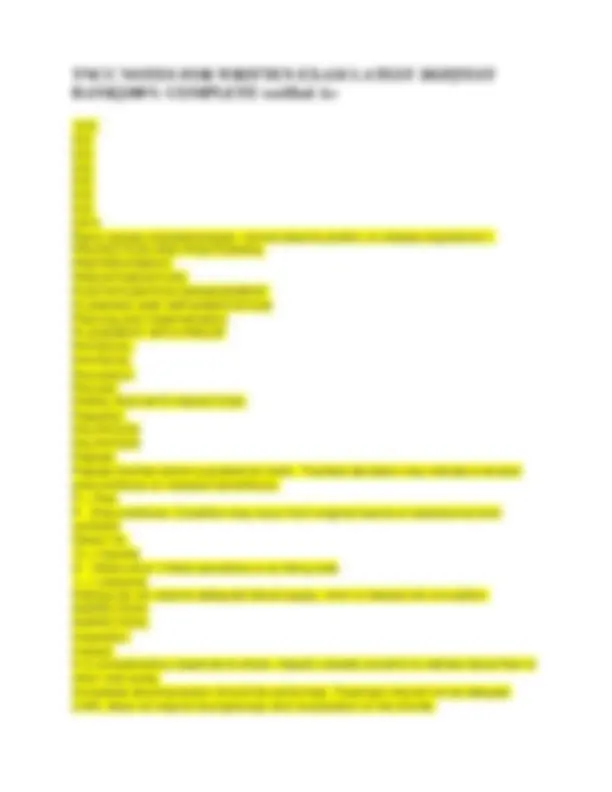

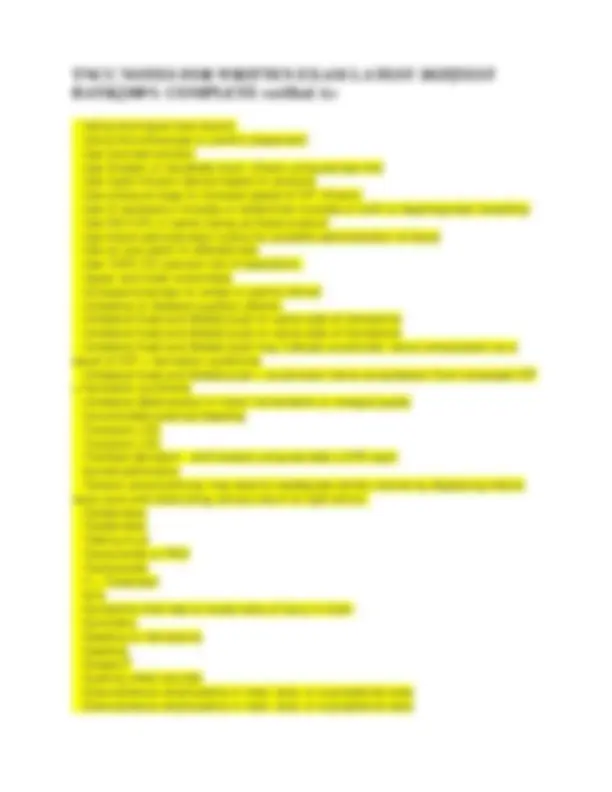


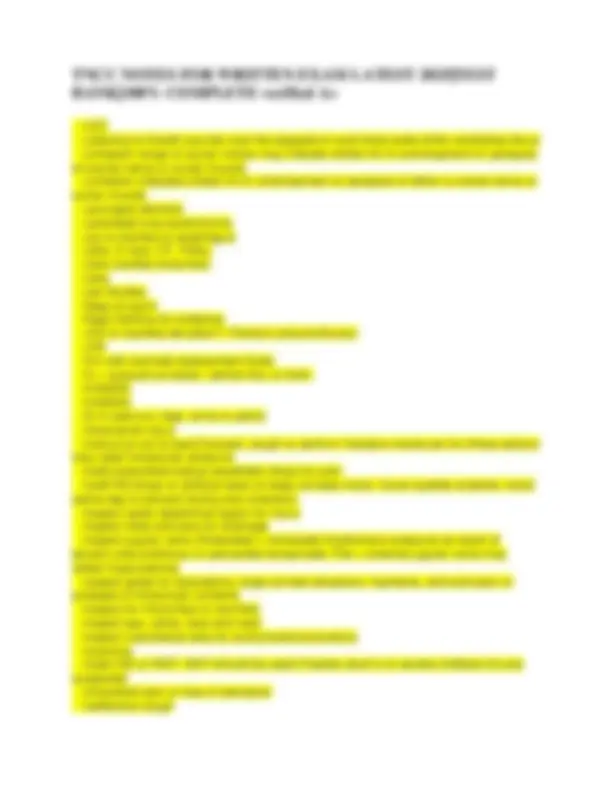


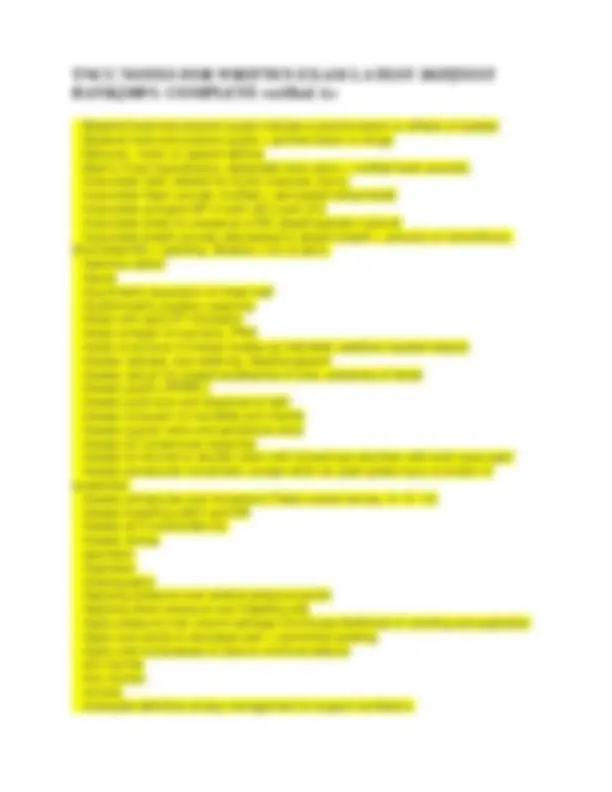






Study with the several resources on Docsity

Earn points by helping other students or get them with a premium plan


Prepare for your exams
Study with the several resources on Docsity

Earn points to download
Earn points by helping other students or get them with a premium plan
Community
Ask the community for help and clear up your study doubts
Discover the best universities in your country according to Docsity users
Free resources
Download our free guides on studying techniques, anxiety management strategies, and thesis advice from Docsity tutors
TNCC NOTES FOR WRITTEN EXAM LATEST 2024-2025 TEST BANK 100% COMPLETE verified A+.pdf
Typology: Exams
1 / 23

This page cannot be seen from the preview
Don't miss anything!
















With any eye injury, what should the evaluation and ongoing assessments be? - ans- Reassessing visual acuity at reasonable intervals Why does herniation occur? What are the symptoms? - ansBecause of uncontrolled increases in ICP. Where do you listen to auscultate breath sounds? - ansAuscultate the lungs bilaterally at the second intercostal space midclavicular line and at the fifth intercostal space at the anterior axillary line. What she be done after the Secondary Assessment? - ansReassess: What medications are used during intubation? - ansLOAD Mnemonic: What is vascular response? - ansAs blood volume decreases, peripheral blood vessels vasoconstrict as a result of sympathetic stimulation via inhibition of baroreceptors. Arterioles constrict to increase TPR and BP. What is the second thing assessed under the Secondary Assessment? - ansGIVE COMFORT MEASURES What is the planning and implementation for thoracic injury? - ansp. 142 What is the Mnemonic for the Secondary Assessment? - ansF = Full set of VS/Focused adjuncts (includes cardiac monitor, urinary catheter, and gastric tube)/Family presence What is the Mnemonic for the Initial Assessment? - ansA = Airway with simultaneous cervical spine protection What is the Law of Conservation of Energy? - ansEnergy can neither be created nor destroyed. It is only changed from one form to another. What is the first thing assessed under the Secondary Assessment? - ansFULL SET VS / FOCUSED ADJUNCTS / FAMILY PRESENCE What is the DOPE mnemonic? - ansD - Displaced tube What is Surgical Cricothyrotomy? - ansMaking an incision in cricothyroid membrane and placing a cuffed endo or trach tube into trachea. This is indicated when other methods of airway management have failed and pt cannot be adequately ventilated and oxygenated. What is renal response? - ansRenal ischemia activates release of renin. What is Newton's Second Law? - ansForce equals mass multiplied by acceleration of deceleration. What is Newton's First Law? - ansA body at rest will remain at rest. A body in motion will remain in motion until acted on by an outside force. What is Needle Cricothyrotomy - ansPercutaneous transtracheal ventilation. (temporary) What is LeFort III fracture and its S/S? - ansComplete craniofacial separation involving maxilla, zygoma and bones of cranial base. This fx is frequently associated w/leakage of CSF and fx mandible. What is LeFort II fracture and its S/S? - ansPyramidal maxillary fx=middle facial area. Apex of fx transverses bridge of nose. Two lateral fx's of pyramid extend through the lacrimal bone of the face and ethmoid bone of skull into the median portion of both orbits. Base of the fx extends above level of the upper teeth into maxilla. CSF leak is possible.
What is LeFort I fracture and its S/S? - ansTransverse maxillary fx that occurs above level of teeth and results in separation of teeth from rest of maxilla. What is kinetic energy (KE)? - ansKE equals 1/2 the mass (M) multiplied by the velocity squared. What is kinematics? - ansA branch of mechanics (energy transfer) that refers to motion and does not consider the concepts of force and mass of the object or body. What is hyphema and its S/S? - ansAccumulation of blood, mainly RBC's that disperse and layer within the anterior chamber. A severe hymphema obscures entire anterior chamber + will diminish visual acuity severely or completely. Injuries are graded on amount of blood in chamber (Grades I-IV). What is diffuse axonal injury and its signs and symptoms? - ans(DAI) is widespread, rather than localized, through the brain. Diffuse shearing, tearing and compressive stresses from rotational or accerleration/deceleration forces resulting in microscopic damage primarily to axons within the brain. What is Cushing's phenomenon or Cushing's Reflex? - ansTriad of progressive HTN, bradycardia and diminished respiratory effort. What is assessed under the Mnemonic "I"? - ansINSPECT POSTERIOR SURFACES What is assessed under the Mnemonic "H"? - ansHISTORY / HEAD-TO-TOE ASSESSMENT What is assessed and intervened for Expose/Environmental Controls? - ans- Remove clothing What is an epidural hematoma and its S/S? - ansResults when a collection of blood forms between the skull and the dura mater. Bleeding is arterial=blood accumulates rapidly: What is a subdural hematoma and its S/S? - ansA focal brain injury beneath the dura mater that results from acceleration/deceleration. Usually venous, and not necessarily from a fx. Formation may be acute or chronic. What is a pulmonary contusion? - ansThey occur as a result of direct impact, deceleration or high-velocity bullet wounds. It develops when blood leaks into lung parenchyma, causing edema + hemorrhage. This usually develops overtime and not immediately. What is a Laryngeal Mask Airway? - ansLooks like an ET tube but is equipped with an inflatable, elliptical, silicone rubber collar at the distal end. It is designed to cover the supraglottic area. What is a flail chest? - ansA fracture of two or more sites on two or more adjacent ribs, or when rib fractures produce a free-floating sternum. What is a concussion and its signs and symptoms? - ansA temporary change in neurologic function that may occur as a result of minor head trauma. What is a Combitube? - ansA dual-lumen, dual-cuff airway that can be placed blindly into the esophagus to establish an airway. If inadvertently placed into trachea, it can be used as a temporary ET tube. There are only two sizes: small adult and larger adult. What is a cerebral contusion and its S/S? - ansA common focal brain injury in which brain tissue is bruised and damaged in a local area. Mainly located in frontal and
What are signs of ineffective circulation? - ans- Tachycardia What are signs of ineffective breathing? - ans- AMS What are signs of a serious eye injury? - ans- Visual disturbances What are S/S with tracheobronchial injury? - ansBlunt trauma. "Clothesline-type" injuries. What are S/S with blunt cardiac injury? - ans"Cardiac contusion" or "concussion." Common with MVC or falls from heights. What are S/S of penetrating trauma/open or ruptured globe? - ans- Marked visual impairments What are s/s of chemical burns to the eye? - ansChemical injuries require immediate intervention if it is to be preserved. What are S/S of a ruptured diaphragm? - ans(Anything below the nipple line and should be evaluated for potential diaphragmatic injury). What are S/S of a rib fracture? - ans- Dyspnea What are neck injury S/S? - ans- Dyspnea What are intracerebral hematoma's and its S/S? - ansOccur deep within brain tissue, may be single or multiple and commonly associated with contusions (frontal & temporal lobes). They result in significant mass effect, leading to increased ICP and neurologic deterioration. What are factors that contribute to ineffective ventilation? - ans- AMS What are aortic injuries S/S? - ans- Hypotension V = Verbal Upon initial assessment, what type of oxygen should be used for a pt breathing effectively? - ansA tight-fitting nonrebreather mask at 12-15 lpm. U = Unresponsive Spinal shock = areflexia and flaccidity associated with lower motor neuron involvement in complete cord injuries; reflexes return with resolution of spinal shock. Some causes: Some causes: Some causes: Slightly elevated BP could protect against brain ischemia in a pt with high ICP. Cerebral ischemia can lead to increased concentration of CO2 and decreased concentration of O2 in cerebral vessels. CO2 dilates cerebral blood vessels = increase blood volume and ICP. Shock stimulates hypothalamus to release corticotropin-releasing hormone that stimulates pituitary to release ACTH that stimulates adrenal gland to release cortisol. Septic shock from bacteremia is distributive shock. Endotoxins and other inflammatory mediators cause vasodilation, shunting of blood in microcirculation, and other perfusion abnormalities. S/S: S/S: S/S: S/S:
S/E's Renin causes angiotensinogen, normal plasma protein, to release angiotensin I. PROTECTION AND POSITIONING: PRETREATMENT: PREOXYGENATION: POSTINTUBATION MANAGEMENT: PLANNING AND IMPLEMENTATION Planning and Implementation PLACEMENT WITH PROOF PHYSICAL: PHYSICAL Percussion: Percuss: PARALYSIS WITH INDUCTION: Palpation: PALPATION PALPATION Palpate: Palpate trachea above suprasternal notch. Tracheal deviation may indicate a tension pneumothorax or massive hemothorax. P = Pain P - Pneumothorax: Condition may occur from original trauma or barotrauma from ventilator Obtain Hx. O = Opioids O - Obstruction: Check secretions or pt biting tube L = Lidocaine Kidneys do not receive adequate blood supply, renin is release into circulation. INSPECTION: INSPECTION: Inspection: Inspect: In a compensatory response to shock, hepatic vessels constrict to redirect blood flow to other vital areas. Immediate decompression should be performed. Treatment should not be delayed. ILMA, does not require laryngoscopy and visualization of the chords.
Epi stimulates receptors in heart to increase force of cardiac contraction (positive inotropy) and increase HR (positive chronotropy) to improve cardiac output, BP and tissue perfusion. Effect of cortisol release is elevation in blood sugar and increased insulin resistance and gluconeogenesis, hepatic process to produce more sugar. E = Expose/Environmental controls (remove clothing and keep the patient warm) E - Equipment failure: pt may have become detached from equipment or there's a kink in the tubing Disruptions of the bony structures of the skull can result in what? - ansDisplaced or nondisplaced fx's causing CSF leakage b/c of lac to the dura mater, creating a passage for CSF. Diminished BS: Diagnostic Procedures: Diagnostic Procedures: DIAGNOSTIC PROCEDURES Define uncal herniation. - ansThe uncus (medial aspect of the temporal lobe) is displaced over the tentorium into the posterior fossa. This herniation is the more common of the two types of herniation syndromes. Define tension pneumothorax. - ansLife-threatening injury. Air enters pleural space on inspiration, but air cannot escape on expiration. Rising intrathoracic pressure collapses lung on side of injury causing a mediastinal shift that compresses the heart, great vessels, trachea and uninjured lung. Venous return impeded, cardiac output falls, hypotension results. Define Severe Head Trauma. - ansPostresuscitative state with GCS score of 8 or less. Define Pneumothorax. - ansResults when an injury to lung leads to accumulation of air in pleural space w/subsequent loss of negative intrapleural pressure. Partial or total collapse of lung may ensue. Define Moderate Head Trauma - ansPostresuscitative state with GCS 9-13. Define Minor Head Trauma. - ansGCS 13- 15 Define Hemothorax. - ansAccumulation of blood in the pleural space. Define central or transtentorial herniation. - ansA downward movement of the cerebral hemispheres with herniation of the diencephalon and midbrain through the elongated gap of the tentorium. D = Disability (neurologic status) D = Defasiculating agents CSF leaks through the nose (rhinorrhea) or the ears (otorrhea). A potential entrance for invading bacteria. Cortisol also causes renal retention of water and sodium, a compensatory mechanism to conserve body water. Complications include: Complications include: Chronic pt's " " up to 2 wks post injury C = Circulation
B = Breathing Auscultation: Auscultate: As volume of one increases, the volume of another decreases to maintain ICP within normal range. As shock progresses, glycogenolysis is activated by epi to break down glycogen into glucose. As ICP rises, CPP decreases, leading to cerebral ischemia and potential for hypoxia and lethal secondary insult. Hypotensive pt w/marginally elevated ICP can be harmful. Angiotensin-converting enzyme from the lungs converts into angiotensin II. Angiotensin II causes: An open pneumothorax results from wound through chest wall. Air enters pleural space both through the wound and trachea. Also: meningitis or encephalitis or brain abscess Acute pt's hematoma manifest 48 hrs post injury A = Atropine A = Alert